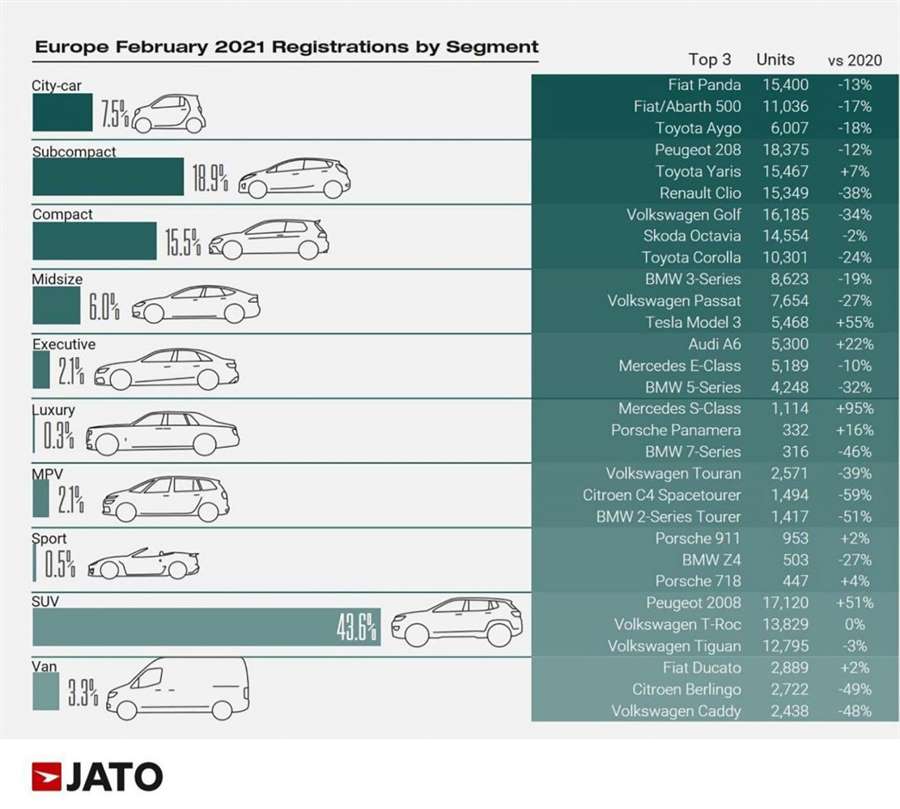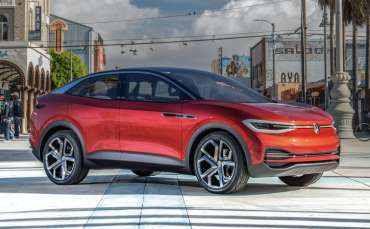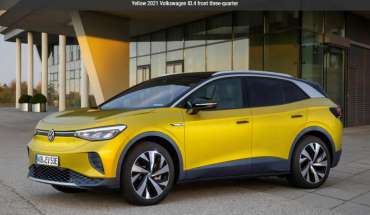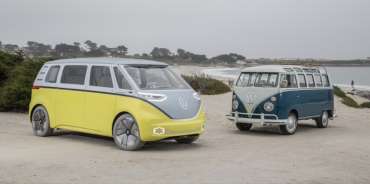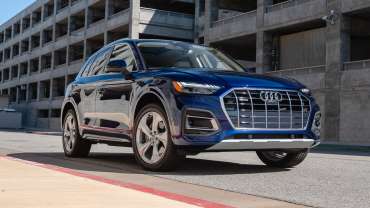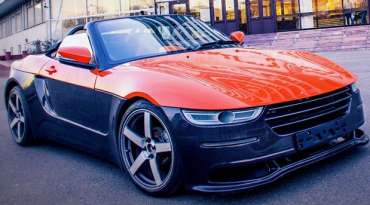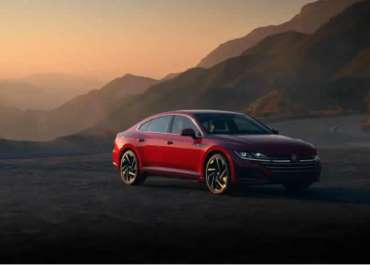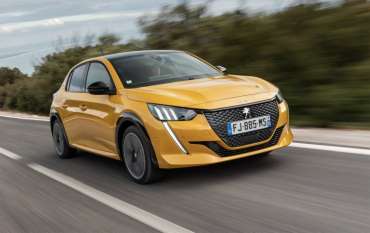
Worldcarblog.com
VW came up with the name from its e-vehicle: It will be called the Voltswagen
Automotive giant Volkswagen will rename its electric vehicles in the US to ‘Voltswagen’. It has not yet been confirmed whether this will apply to vehicles sold in Europe.
The news allegedly briefly appeared on the American press page yesterday, but was soon removed. Volkswagen's PR, Brendan Bradley, did not comment on the allegations, but according to media reports, a source close to the company said it was a permanent change that would apply to VW in America and would clearly separate electric models from conventional ones.
Although not confirmed, the German brand is not expected to change the name of its e-vehicles in Europe either.
A USA Today reporter quoted part of an official announcement stating that the Voltswagen is more than a name change.
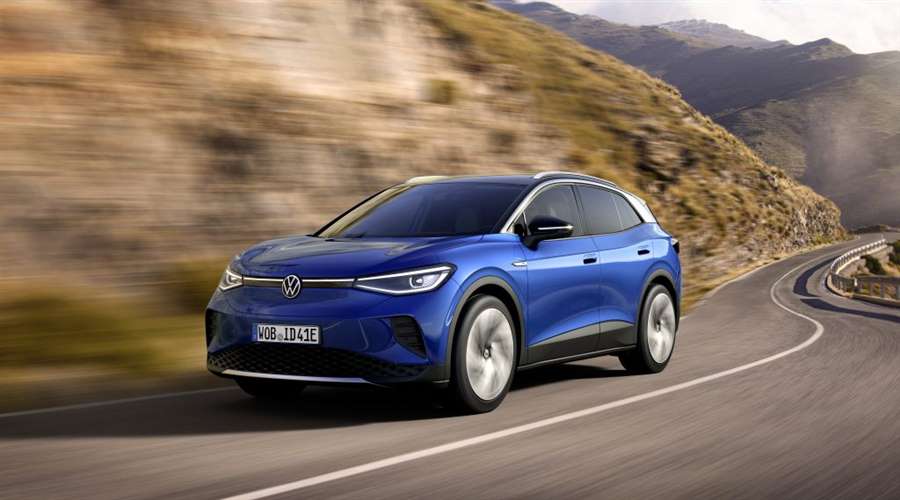
"It is a public declaration by which the company announces future investments in e-mobility," reads the statement.
According to that announcement, electric cars will get the inscription Voltswagen, while the others will keep the classic VW logo.
This news comes at a time when Volkswagen is starting to commercialize the ID.4 electric crossover, the first that could seriously change the power relations in the electric vehicle market in America, Index.hr reports.
Recall, VW has announced 70 electric models by 2029, as well as sales of one million electric cars by 2025.
Volkswagen ID.4 review
The Volkswagen ID.4 is a fully electric SUV that is a logical extension of the excellent Golf-sized ID.3 hatchback family. It's on UK sale now, but only as the ID.4 1st Edition initially, costing a hefty £40,800 now that it is no longer eligible for the government's plug-in car grant. Expect a wider range of models, specs and trims to be made available throughout 2021.
Under the ID.4's SUV bodywork is VW's dedicated electric vehicle technology that will be shared with a number of other Audi, Cupra, SEAT and Skoda EVs, such as the Enyaq. The understructure contains all the electric drive components, such as the motor and batteries, and is purpose-built to be as efficient as possible as there are no petrol or diesel derivatives to engineer.
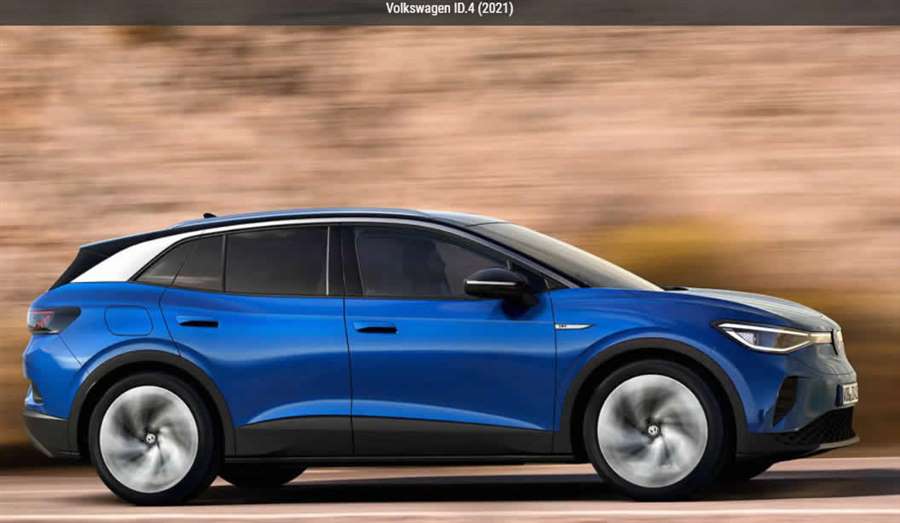
As a result, the ID.4 is even roomier and more practical than the ID.3, despite their close similarities under the skin.
Electric rivals are few and far between, but the smaller Peugeot e-2008 is already in showrooms, and might be worth considering if you don't want to wait for a cheaper ID.4. At the other end of the price scale, the Volvo XC40 Recharge P8 will go up against more expensive ID.4s.
What's under the skin?
Nestled under the ID.4's boot floor is an electric motor that drives the rear wheels. Buyers who need four-wheel drive will have to wait until later in 2021 for models fitted with a second motor to power the front axle. Don't expect the VW to be dazzling off-road, though, even though its ground clearance is usefully high at 21cm.
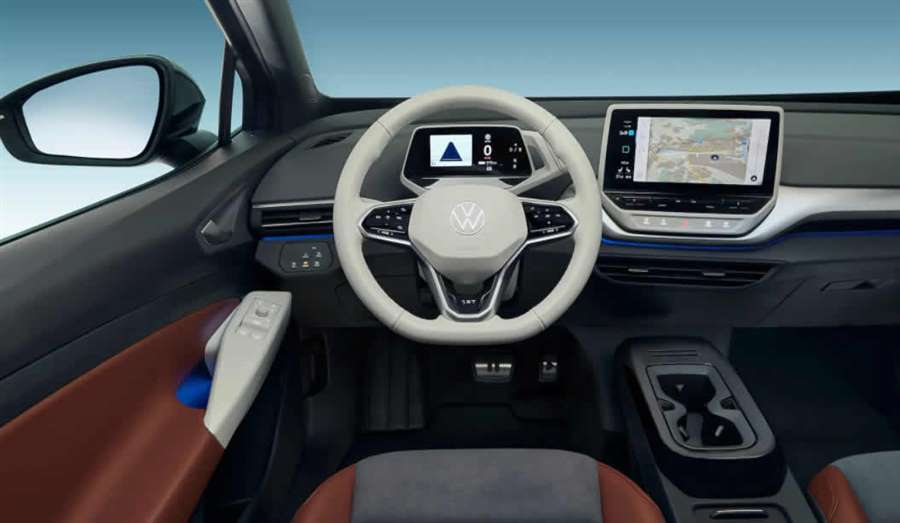
Top speed is electronically capped at 99mph so that battery reserves aren't needlessly wasted driving at extreme speeds, while the 0-62mph sprint takes just 8.5 seconds.
All ID.4 1st Editions come with a 77kWh battery pack giving a claimed range of 310 miles. Although that figure has been achieved using the latest WLTP standards designed to reflect real-world driving, we found the range meter read around 220 miles on a crisp spring morning. Hooked-up to a rapid 125kW public charger, the car's battery can be replenished to 199 miles of range in just 30 minutes.
As the line-up expands, a smaller battery size will come on stream with lower purchase prices to match.
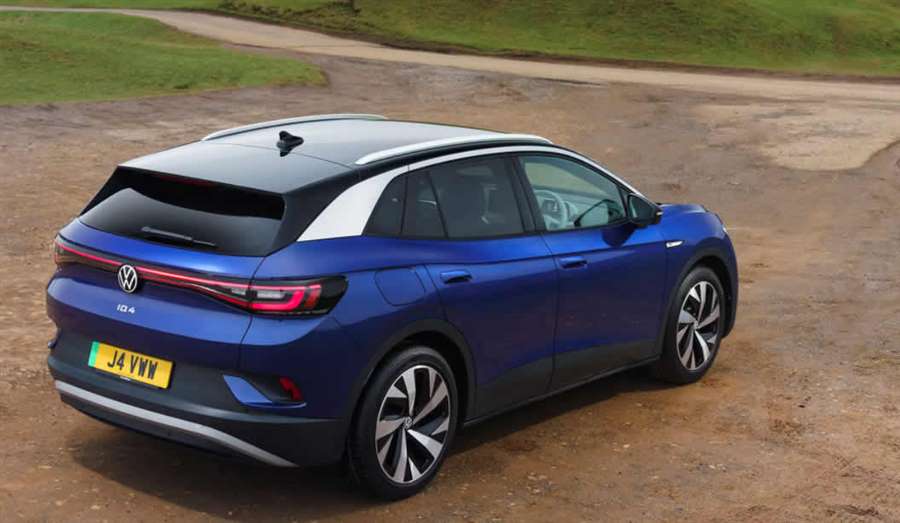
What's the ID.4 like inside?
Thanks to the dedicated EV hardware and lack of transmission tunnel, there's plenty of space for passengers, while you get full digital displays alongside what VW describes as intuitive voice control and touch surfaces to operate most minor functions.
Inside, the interior design theme is essentially the same as that found in the ID.3, even if there's more space inside. It's a clean-looking cockpit with a twist-action gear selector attached to the drivers’ instrument pod and storage cubbies in the centre console.
An augmented-reality head-up display is on the options list, while the connected infotainment system has real-time traffic data, live updates on the state of nearby chargers and the ability to pre-condition your car via a phone app, meaning no need to get into a chilly or frosted-up car on a frozen morning.
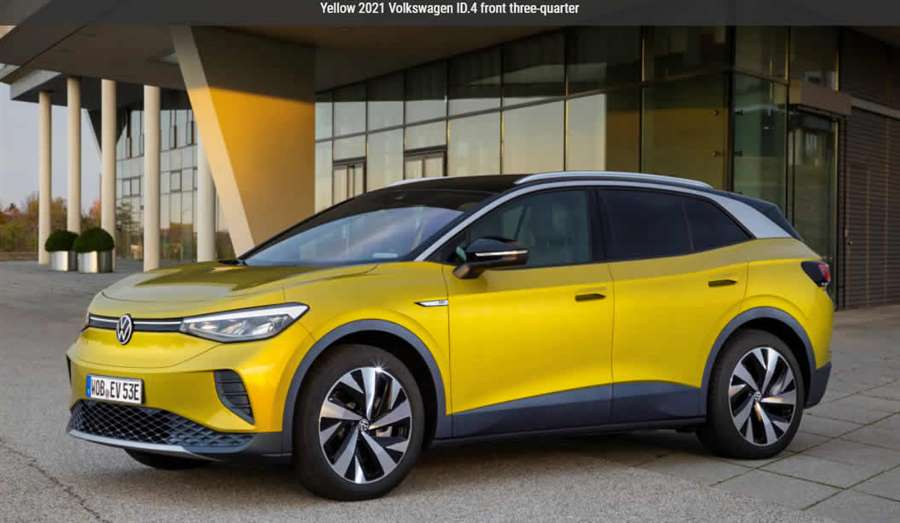
As you would expect, the ID.4 1st Edition is packed with standard equipment, including soft-touch grey and brown fabric upholstery, 20-inch alloy wheels, full LED exterior lights, darkened rear privacy windows, adaptive cruise control, a 10-inch multimedia touchscreen and 30 (yes, thirty!) different colours for the interior ambient lighting.
What's it like to drive?
It's better than its podgy looks might lead you to believe. Thanks to excellent weight distribution and that low-down battery pack, the ID.4 grips and steers very well indeed. Even when fitted with the optional 21-inch wheels and super low-profile tyres, the ride remains compliant on most surfaces, and it doesn’t get too jarring when you switch modes from Comfort to Sport.
This 204hp version isn't as fast as you'd expect, as performance is hampered by a hefty kerbweight of more than two tonnes. It's quick enough for a car of this type and performance is well judged, but we'd warn that lower-output versions may not have enough performance if you regularly undertake long journeys or travel with multiple passengers onboard.
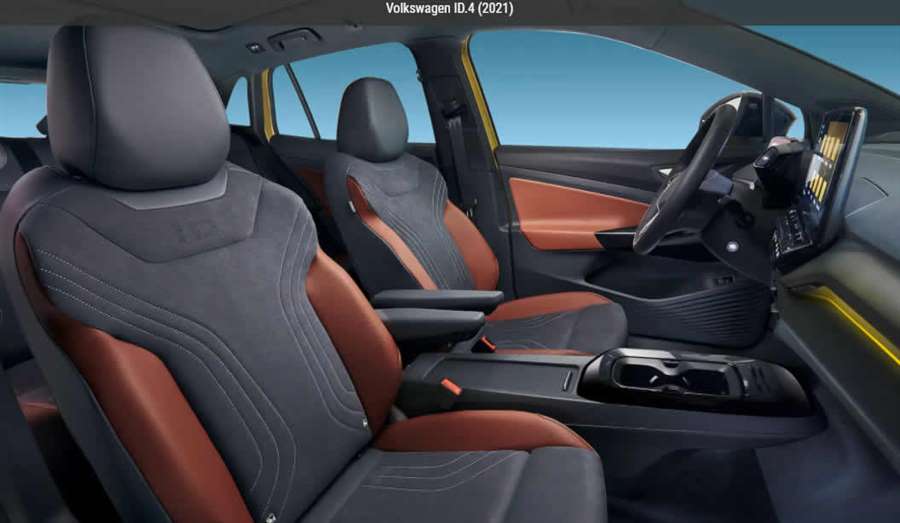
Volkswagen ID.4 (2021) driving, rear viewEnlarge0videoEnlarge22photo
It is quiet, however. This is a really hushed, cosseting drive, and best driven in a more relaxed manner. This will also help the battery range and brings out the best in the comfort-orientated chassis.
There's a toggle switch on the steering column that lets you select the level of regenerative braking on offer. This is a similar system to other electric cars, which allow 'one-pedal' driving, slowing down significantly by lifting off the accelerator, rather than braking conventionally.
For added convenience - and as expected by many SUV owners - a towbar can also be specified for the ID.4, allowing it to haul braked trailers of up to 1,000kg.
Should you buy a Volkswagen ID.4 SUV?
Yes, although it's not perfect. And if we're being honest, it doesn't feel quite as brilliant or refreshing as the Volkswagen ID.3 – the car it's so closely related to. But we'd say it has a more pleasing cabin, and as such the ID.4 feels like the future has suddenly arrived and we largely like what we see.
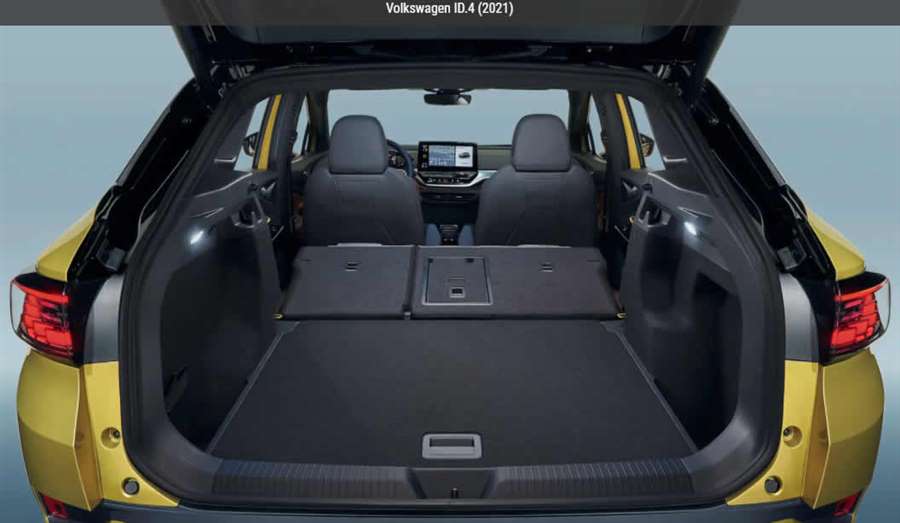
It's a little too early for a definitive verdict as right now, we just get the top-spec 1st Edition model, which weighs in in at £40,800 now that it is no longer eligible for the government plug-in car grant. Following the ID.3's logic, lower powered less well-equipped models will take the ID.4 down into the early £30,000s, which will open it up to far more buyers.
As such, we expect the cheaper, more mainstream models will be much more appealing – this is fundamentally an excellent electric SUV that will undoubtedly fit into the lifestyles of a large amount of families who are yet to buy an EV. The biggest unknown yet to answer is whether we rate the ID.4 ahead of the closely related Skoda Enyaq.
It's had a lengthy gestation, not least because of the Coronavirus (COVID-19) pandemic and some teething issues with the ID.3's software, but right now the ID.4 looks very promising indeed.
Confirmed: The cult Volkswagen Microbus returns (PHOTO, VIDEO)
The return of legends such as Renault 5, Renault 4, Opel Manta and others has already been announced. But in electrical editions. So, as we have already written on our portal, it is definitely that car manufacturers will look for inspiration in the past, in order to find a way to bring new electric models closer to customers. In other words, it will capture emotions. And they will succeed.
Now another twist is happening in the story of the return of the legendary Microbus. As the American Car & Driver finds out, Volkswagen has not given up on the successor based on the ID Buzz concept.
VW leaders were not shaken by the fact that Buba did not perform the best in recent years. Reportedly, the successor of the Microbus will be presented in 2022, Index.hr reports. This was confirmed by Carsten Intra, the head of VW commercial vehicles, saying that the successor will be the passenger MPV vehicle, which will also be offered in Europe in the delivery version.
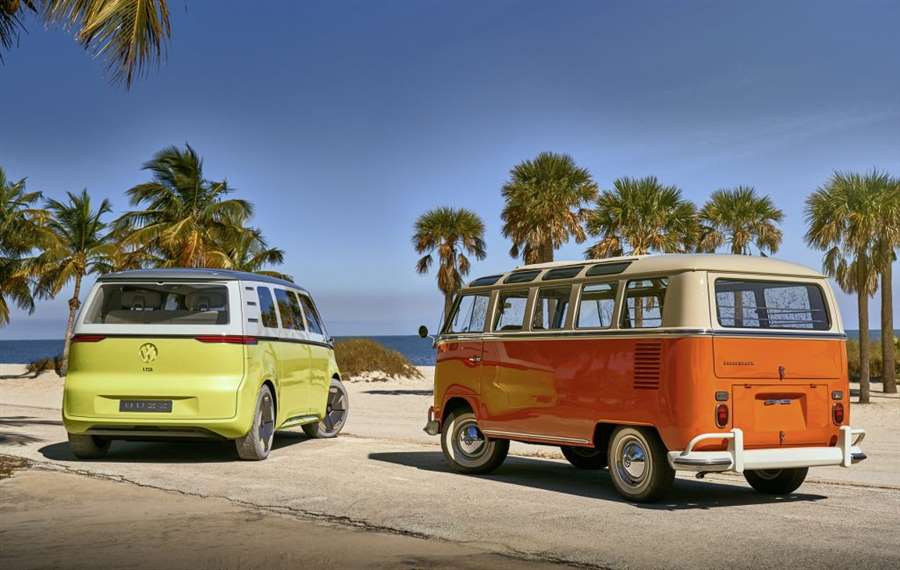
As expected, ID Buzz will have exclusively electric drive, probably in several variants, ranging from 200 to 300 hp, with the strongest having two electric motors and all-wheel drive.
A diverse offer of battery sets is also expected, the maximum of which would be the capacity of as much as 111 kWh. In that case, an appropriate range of 550 km should be expected. There is also talk of solar panels that could increase the range by another kilometer.
What no one still dares to estimate is the price of a car like this. Rich equipment, advanced drive and such large batteries in today's framework mean only one thing - an extremely high price.
{vembed Y=CO5HTB0kSZY}
2021 Audi Q5 First Test: The Popular Kid Gets a Fresh Wardrobe
Audi’s most popular model gets a midcycle refresh but leaves us wanting a bit more.
Just before 2020 ended, we had the chance to drive the 2021 Audi SQ5, the sportier variant of the Q5 powered by a punchy V-6 engine. Like we noted back then, the SQ5 delivers the best of both worlds. It's a comfortable SUV that's great for everyday driving, but also more dynamic when the road turns twisty. Now, we've driven and tested the 2021 Audi Q5, the toned-down normal version that competes in the compact-luxury-SUV segment, one of today's most popular. As you'd expect, then, the Q5 is indeed Audi's most popular model, making up 25 percent of the brand's sales, with the conventionally powered, non-S version responsible for most of that chunk (the balance includes not just SQ5s, but also Q5 PHEVs).
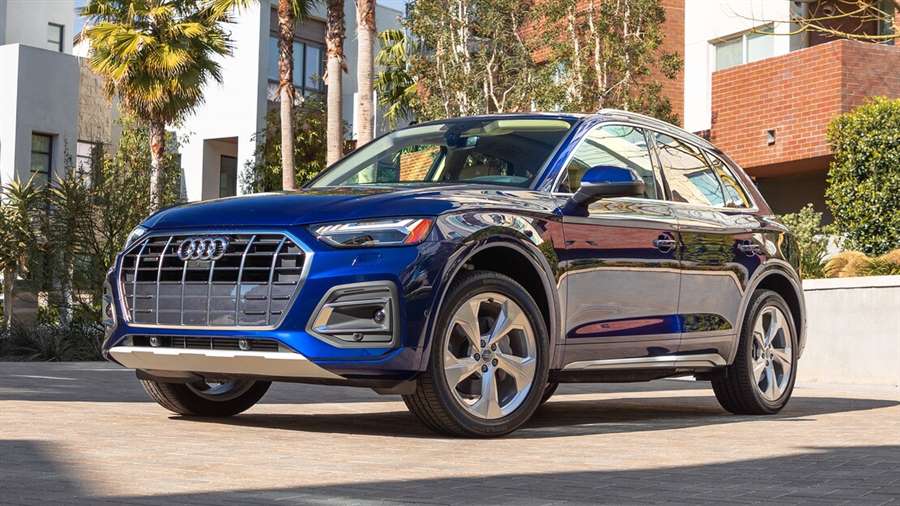
In order to be a popular player in one of the toughest segments, the Q5 has to bring plenty of goodness to the table, no? It combines attractive styling with a well-appointed cabin, all while keeping its prices competitive—something hard to find these days in the luxury game. For the 2021 model year, the Q5 received a midcycle refresh inside and out to bring more glamour and a bit more tech.
2021 Audi Q5: More Soft Than Sporty
As one would expect, the regular Q5 is toned down compared to the S variant, and that was notable during our time with this SUV. Powered by a 2.0-liter turbo I-4 with 261 horsepower and 273 lb-ft of torque, the Q5 employs a seven-speed dual-clutch transmission that sends power to all four wheels thanks to Audi's Quattro system. The engine is mated to a 12-volt mild hybrid system that's new for 2021, and which adds a combined 13 hp over the 2020 model.
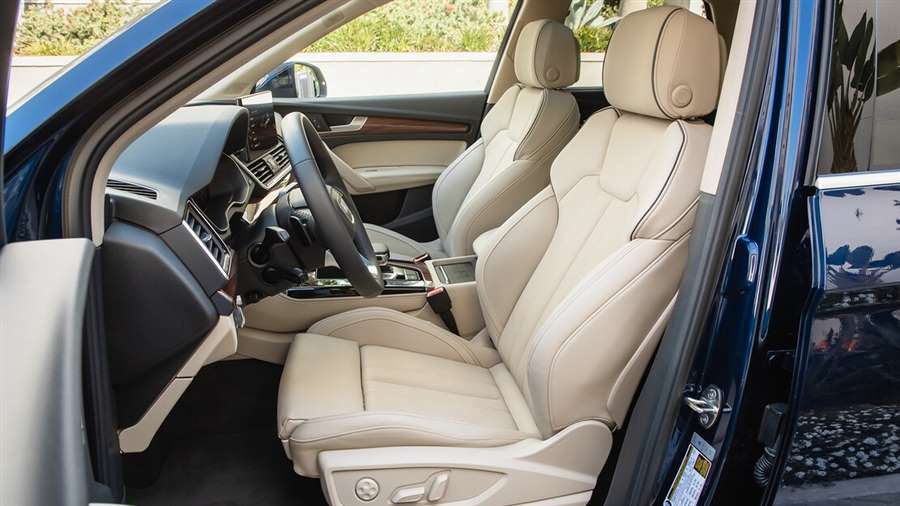
That combination makes the Q5 a decent SUV on the road. The engine is lively, and while it lacks the push of a V-6, it feels completely adequate for an SUV this size. The one complaint we have is with the transmission taking too long to downshift, which we experienced mostly when trying to pass on the freeway. The engine also has a bit of turbo lag, which combines with the transmission issue to compound the sensation that it's weaker than reality when trying to pile on speed or pass another vehicle at freeway velocities. When reaching a cruising speed, though, the Q5 is in its element.
Drivers can choose between five driving modes—Efficiency, Comfort, Auto, Dynamic and Individual. We spent most of the time driving in Auto, but even when we turned on Dynamic mode, the Q5 had the same laggy feel as in Auto or Comfort. Even so, at the test track, associate road test editor Erick Ayapana was able to go from zero to 60 mph in 5.7 seconds, which is a strong number. Pedal overlap causes the transmission controller to launch at about 3,000 rpm, after which gearshifts are much more immediate and aggressive, according to Ayapana. That may be the trick to get an eager start, but it's not how you drive every day. Compared to a 2018 model, the 2021 Q5 was faster to 60 mph by 0.2 second, perhaps thanks to the mild hybrid system.
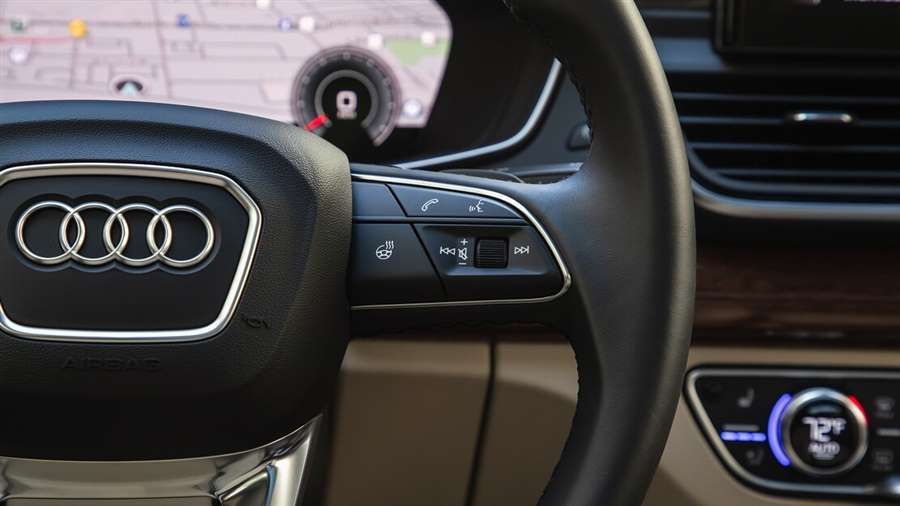
Overall, the ride is settled and comfortable. Whether you drive over harsh pavement or ruts, the suspension does a good job absorbing those imperfections before they get into the cabin. Even on twisty roads, the body is well controlled with little noticeable roll, but chief tester Chris Walton had mixed feelings during our figure-eight test, noting poor body control under braking and cornering. "The transmission, even in dynamic mode with S Drive, was not intelligent enough to hold second gear on the skidpad," Walton added.
Besides increasing power output and (potentially) lowering the Q5's acceleration time, the mild hybrid system also helps with fuel economy. For 2021, the Q5 delivers 23/28/25 mpg city/highway/combined, an increase of 1 mpg in city and combined ratings over last year.
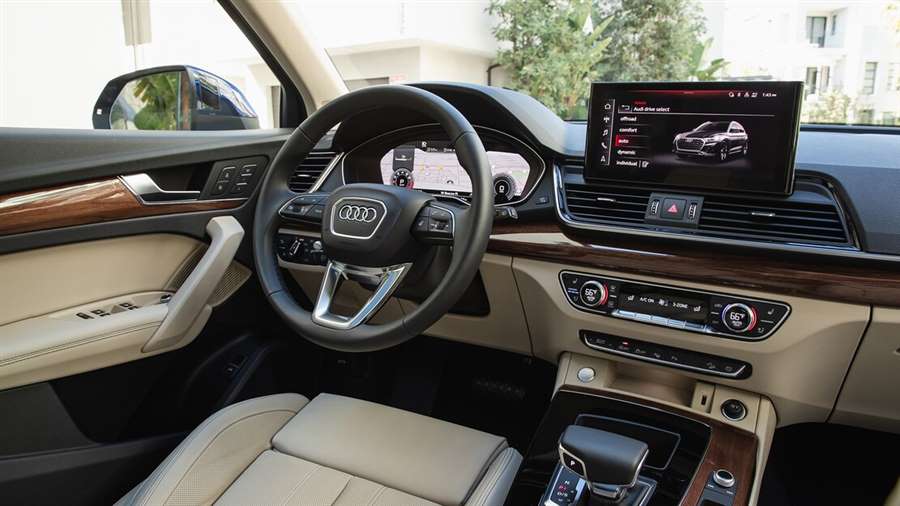
2021 Audi Q5: Comfortable And Elegant
Inside, the Q5 blends a mix of premium quality and high tech. While it doesn't have the same avant-garde interior aesthetic as do the Q7 or the Q8 (these have a two-screen infotainment/HVAC setup on the center console), the Q5 features a 10.1-inch touchscreen atop the dash. It displays Audi's newest infotainment system—MIB 3—which is easy to use and fast to respond. The graphics are top notch, and the way everything is organized makes it easy to get around without having to dig through menus. Apple CarPlay and Android Auto are wireless, and you can use voice commands to do unusual things like change the temperature or other settings in the car.
Our Prestige model—the Prestige trim costs $10,700 over a base Q5—checked pretty much every available box, which included everything from the 19-speaker Bang & Olufsen premium audio system with 3D sound to Audi's "virtual cockpit," whereby a 12.3-inch display serves as the instrument panel and can show real-time Google Maps graphics. Our model also came with other goodies like a head-up display, a 360-degree bird's eye view camera system, and a panoramic sunroof.
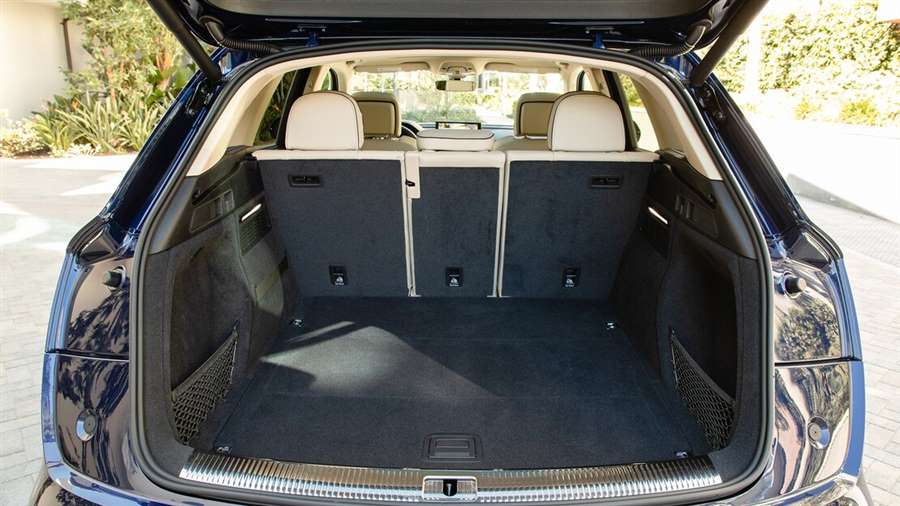
To maximize comfort, Audi also offers heated and cooled front cupholders, heated rear seats, heated and ventilated front seats, and a heated steering wheel. The second-row seats fold almost flat in a 40/20/40 configuration, making it ideal to fit long items between the seats while maximizing passenger space.
And you'll want to maximize the room, as interior space is one of the areas where the Q5 needs to improve. Second-row legroom is a tad tight for adults with long legs. At six feet tall, this author's legs touched the back of the front seat with the driver's seat set to his driving position. Though there weren't any problems with headroom, the noticeable drivetrain hump also interferes with foot room whenever you have three passengers in the rear.
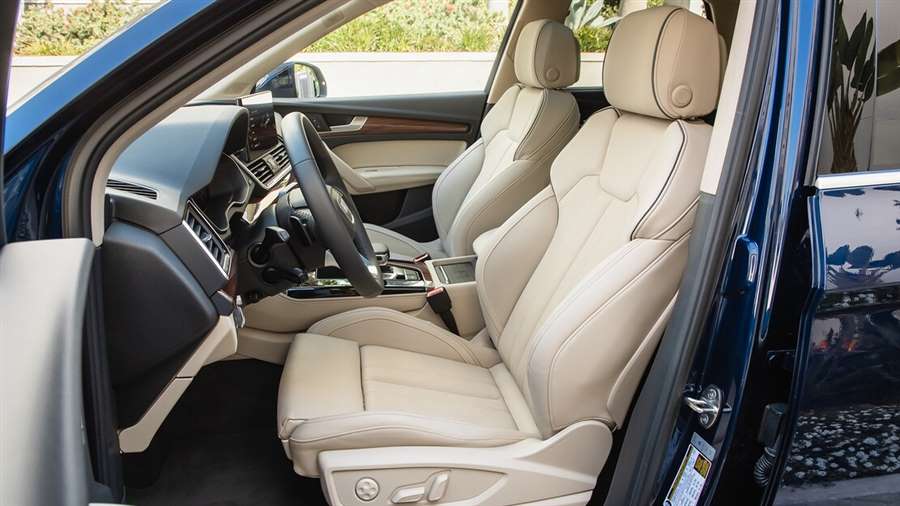
2021 Audi Q5: Safety Tech
Like some other luxury brands these days, the Q5 brings some standard safety systems but charges extra for others. Blind spot monitoring with rear-cross traffic alert, lane departure warning, and parking sensors are standard across the lineup, but adaptive cruise control with traffic jam assist is only available with the Premium Plus and Prestige packages—the two (out of three) highest trims.
These safety systems work well enough on the highway, keeping the Q5 centered in its lane even when lane markings weren't totally clear. We'd like to compare the Audi's systems to those from BMW and Acura, which are among the tops in the segment, to see which truly stands out.
Is The 2021 Audi Q5 Worth It?
Our Audi Q5 Prestige checked out at $56,840, a pricey ask no matter how you look at it. That's several thousand dollars more than a loaded Acura RDX or Lexus NX, but is in line with its loaded German counterparts. Should you have a tighter budget, the Q5 starts at $44,395, with the middle-tier Premium Plus package adding $4,800.
Despite the somewhat lazy-feeling powertrain, it's easy to see why the Q5 is Audi's most popular model. After all, most folks won't stand on it like we do during our holistiic evaluations, and this compact luxury SUV serves up tons of amenities, a well-appointed cabin, and fresh styling that should continue to resonate with a lot of customers. The Q5 is far from perfect, but it does a lot of things well and we can't see this newer version giving up much ground to BMW, Mercedes, Acura, and friends.
Revealed how much the new Russian roadster "Crimea" will cost
The deputy editor-in-chief of "Russia North", Natalija Loseva, published a photo of the new sports car "Crimea", writing that it will cost between 5,500 and 8,900 euros.
"Roadster 'Crimea' is a project of the student corporation 'Bauman' and Russian technical faculties. By the summer, several dozen cars will be produced. The vice-rector of Yaroslavl Technical University showed it to me. It will cost from 5,500 to 8,900 euros in retail, "Loseva wrote on her Facebook account.
The "Roadster Crimea" project was created in 2013, and the initial team of engineers was formed from the first team of the "Formula Student" team at the Moscow State Technical University "Bauman". Students and postgraduates work on the project under the guidance of experienced professors.
In December 2020, a decision was made to form an Interuniversity Youth Engineering and Technology Corporation, which will organize the development of knowledge and educational technologies among universities.
Roadster "Crimea" is made entirely of Russian parts and according to all characteristics, it can compete with foreign cars of the same class.
Volkswagen Arteon Review: Classy in a Class of Its Own
The verdict: As every SUV in the parking lot starts to look the same, the 2021 Volkswagen Arteon near-luxury mid-size hatchback stands out as a roomy, refined and refreshingly pleasant alternative for those willing to look beyond the mainstream sedan and SUV classes.
Versus the competition: Aside from its body style, the Arteon stands apart from other near-luxury mid-size vehicles with (mostly) appealing tech and loads of room — but its premium price tag can be off-putting.
The Arteon, which debuted for model-year 2019 as the spiritual successor to Volkwagen’s CC sedan, got a few changes for 2021, including light exterior styling tweaks, an updated multimedia system and more upscale cabin materials.
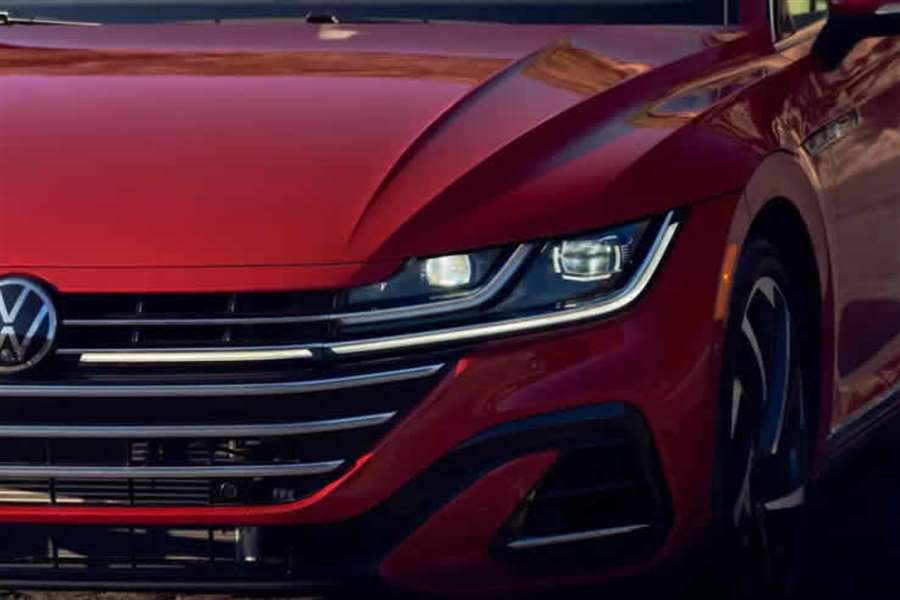
As the only mid-size hatchback in the near-luxury class, the Arteon doesn’t have any direct competition, but Volkwagen says it’s often cross-shopped against sports sedans such as the Acura TLX, Kia Stinger and Nissan Maxima; see the models compared. The automaker also expects the Arteon to appeal to budget-minded shoppers interested in the more expensive Audi A7, from VW’s luxury brand. See them compared.
Punchy Power
Although the Arteon is in the A7’s extended family — and wears sleek and attractive curves reminiscent of its more upscale relative — it’s more of a distant cousin when it comes to road manners. The Arteon is all-around pleasant, but it never rises to exciting like the A7 and Kia Stinger do.
The Arteon’s sole powertrain is unchanged from last year: a 268-horsepower, turbocharged 2.0-liter four-cylinder engine mated to an eight-speed automatic transmission. It’s peppy and responsive from a stop, with smooth, timely shifts for power on demand. Choosing Sport mode amps up accelerator response and sharpens steering feel for a little more excitement.
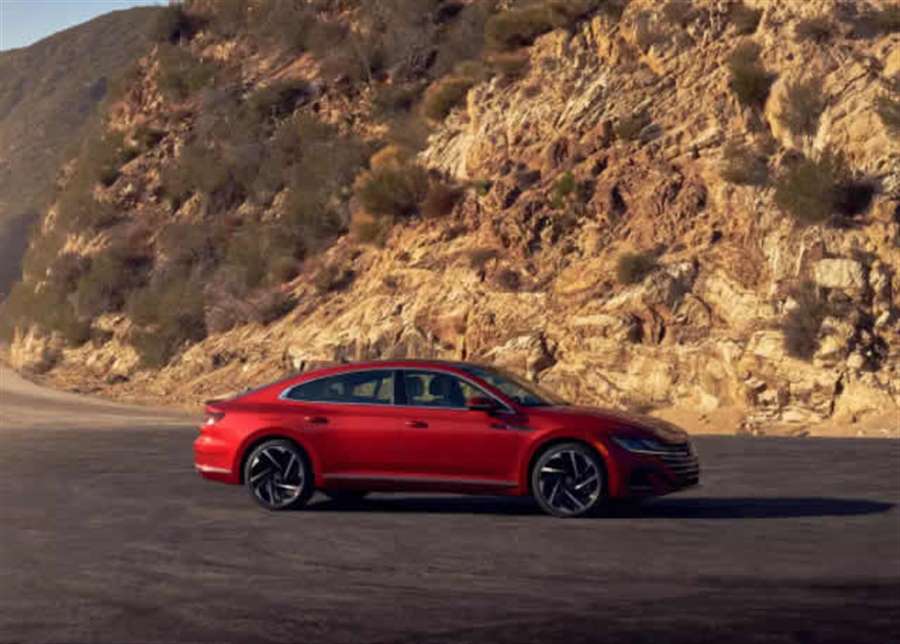
I tested an SEL R-Line trim level with 4Motion all-wheel drive during two weeks of endless precipitation: rain, sleet, snow and ice. It was continuously able to find its legs, with the optional all-wheel-drive system seamlessly adjusting to the elements to provide appropriate traction. Tires always play an important role when snow is involved, and in this case our test car’s Continental ProContact TX all-season tires deserve some credit, too.
The Arteon’s standard adaptive suspension system provides good cushioning from rough roads without sacrificing handling; the hatchback zips through corners with an agile, controlled feeling that’s surprising in a vehicle this long. Overall, its confident handling and composed ride shine both on the highway and around town.
With front-wheel drive, the Arteon is EPA-rated 22/32/25 mpg city/highway/combined with premium gas; AWD drops that estimate to 20/31/24 mpg. That’s in line with competitors — which also prefer premium fuel — such as the front-drive Acura TLX (25 mpg combined) and the base rear-wheel-drive Kia Stinger (25 mpg combined). The V-6-only front-drive Nissan Maxima slightly trails them all, with a combined rating of 24 mpg.
An Unexpected Family Car
In the garages of families I know, a sedan is about as common as a luxury yacht. (Maybe I have the wrong kinds of friends … ) Nearly all the families I know drive an SUV or minivan, including myself; my own car is a minivan, which easily accommodates my family of five. Sedans and hatchbacks were not on my shopping list.
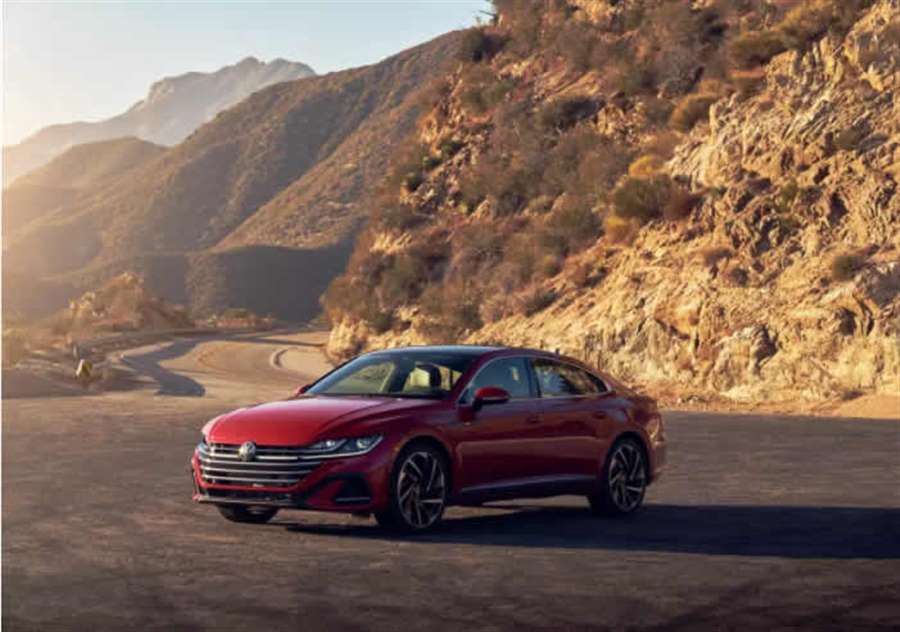
To gauge real-life livability, however, I try to shoehorn my family into everything I test, and, to my surprise, the Arteon can family very well. The backseat is wide and flat, with ample headroom and legroom for two adults to coexist comfortably — or in my case, three kids. Not an easy feat. With my twins’ big boosters in the outside seats and my 10-year-old on a smaller, backless booster in the middle, we fit with no complaining (perhaps an even more difficult feat).
For caregivers with kids in child-safety seats, the Arteon’s exposed Latch anchors make connection struggle-free, and its three top tether anchors were easy to find and use. Check out our Car Seat Check.
Yes, we would’ve had more wiggle room in a minivan or mid-size SUV, but we fit fine in the Arteon — even on a long drive. What’s more, the hatchback carried much more stuff than I expected. When we went sledding, the Arteon’s cargo area swallowed all our gear — large sleds, snacks, mittens, more mittens and bags of extra mittens — with room to spare.
The cargo area is very deep and has a nice wide opening for accommodating bulky items. Also, its hatchback setup gives the cargo area more height than a traditional trunk, so it can hold taller items. The backseat folds in a 60/40 split, and there’s a small center passthrough that’s handy for simultaneously carrying people and long, skinny items.
Manufacturer-provided cargo numbers back up my experience. The Arteon’s hatchback-style cargo area offers 27.2 cubic feet of space with all its seats in place — more than the Volkswagen Tiguan compact SUV, though that car seats seven.
Utility aside, the Arteon is also a nice place to be. Updates for 2021 give the cabin a premium vibe, with a handsome design in my test vehicle highlighted by attractive two-tone Nappa leather-trimmed seats, as well as brushed metal and glossy black trim. There’s also a new ambient lighting system with 30 selectable colors, which reveal themselves through translucent panels in the doors and console — kinda cool. The changes give it a more upscale feel overall than you’ll find in other VW cars, like the Passat or Jetta.
Controls
VW’s new MIB3 multimedia system joins the Arteon cabin, and there’s a lot to like about it — but not all of it.
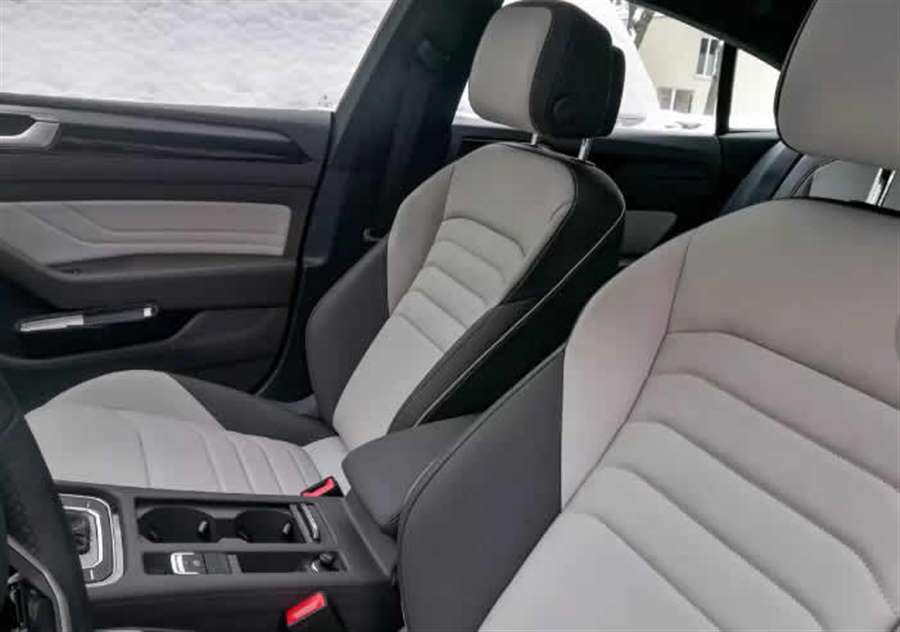
First, the system’s standard 8-inch touchscreen is nestled into the dash within easy reach of the driver’s seat. The screen is responsive, and the system’s menus are straightforward. Wireless Apple CarPlay and Android Auto are now standard, and the integration is seamless. I also found that the system’s voice commands work accurately for navigation and audio functions.
The standard digital cockpit instrument panel was also helpful. Its 10-inch display offers a configurable presentation of vehicle information, including car status, navigation, driving data, phone information and driver assistance features. Having the full-screen navigation view right in front of my eyeballs was especially useful.
That said, a few things need work. While I appreciated the system’s large, traditional volume knob, its tuning knob is odd. It works for some functions, like changing regular radio stations, but does not work for satellite stations.
Also, some editors were disappointed by VW’s switch to touch-sensitive panels on the steering wheel and for climate control, versus traditional buttons and knobs. I mostly didn’t find these problematic to use, but I did struggle with one feature: a slider function for fan speed and temperature. I found it awkward and difficult to use with accuracy, especially compared with pressing a button or turning a dial. There is a workaround, however: To adjust most climate settings, once you’ve touched the button on the climate panel you can use either the touchscreen or the panel to make the adjustment.
Safety and Value
The Arteon is well equipped with standard safety features: Forward collision warning with automatic emergency braking, blind spot warning and rear cross-traffic alert are included on all trims. Available active safety features include lane keep assist, adaptive cruise control with stop-and-go capability and automatic high-beam headlights.
My favorite Arteon safety feature is among the more low-tech ones: its backup camera. Because the lens is protected under the VW badge and pops out only when the transmission is in Reverse, the camera’s view was consistently clear and free from the snow, ice, salt, etc. that otherwise plagued my time with the car. After driving through more than one blizzard in the Arteon — and in other vehicles — I appreciated this small convenience feature, especially given the Arteon’s sloping roofline and small side windows, which hurt rear visibility.
Most trims of the Arteon got a little more expensive for 2021, but its base price of $38,190 is still within range of its competitors; it’s about the same price as the Nissan Maxima and a little less than the Acura TLX. It costs quite a bit more than the Kia Stinger, however, which starts at $34,135 (all prices include destination). Also, prices escalate quickly, with the top trim approaching $50,000.
The Arteon is classy in a class of its own, and offers shoppers an exclusive mix of luxury and utility — minus the seemingly inescapable, everyone-has-one SUV body style.
These are the best-selling models in Europe: Peugeot has overtaken VW
After last year's drastic decline caused by the pandemic, this year we are witnessing great changes in the European market. First of all, we mean that the eternal European bestseller VW Golf is now only in third place. In front of it are, no less you niches, than two models from Peugeot.
As reported by JATO Dynamics, in a market that is down 20%, there has been a sharp rise in the popularity of electrified cars. During February, 115,000 electric vehicles (EV) and plug-in hybrids (PHEV) were sold, which is a share of an excellent 13.6%, reports Index. Recall, a year earlier, in the run-up to the pandemic, the share of electrified vehicles was only 6.5%.
Several companies are above the industry average, including Hyundai (16%), BMW (24%), Daimler (27%), Jaguar Land Rover (31%) and Geely (45%). Of course, Tesla Motors is at the top with a 100% share of electrified vehicles in sales. It can be seen from the report that Jaguar Land Rover came the furthest from the traditional brands in the electrification of the range.
The best-selling electric model in Europe is the Tesla Model 3, with 5,400 units sold and a 55% share. Second is VW ID.3 with 3,557 registrations, and third is Renault Zoe with only 10 copies less, but also a drop of 45%.
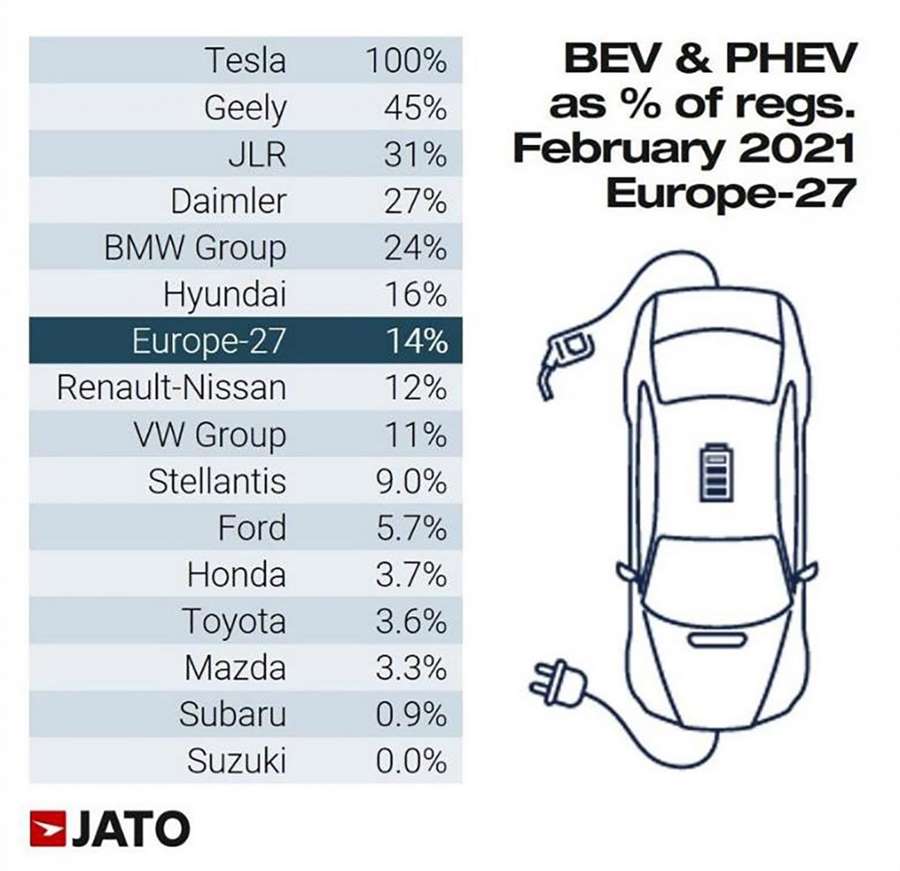
In the PHEV segment, ie plug-in hybrid vehicles, the most popular is the Volvo XC40 with 3,479 units sold, but also with a growth of an incredible 323%. They are followed by the hybrid Peugeot 3008 and Renault Captur with about a thousand copies less. The only market in Europe where electrified vehicles are more popular than traditional ones is Norway. Believe it or not, their share is as high as 79%.
At Peugeot, they are certainly pleased because the best-selling car in Europe is the Peugeot 208 with over 18,000 units sold. It is followed by the 2008 Peugeot crossover, with 17,120 sold, and only in third place is the VW Golf with 16,185 units sold and a drop of 34%.
Take a look at the table and who else was on the Top 10 list for February in Europe.
Segment sales overview - SUV models are still the most sought after.
